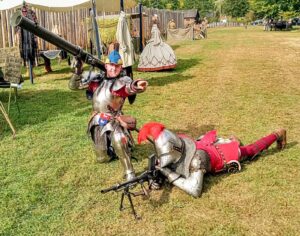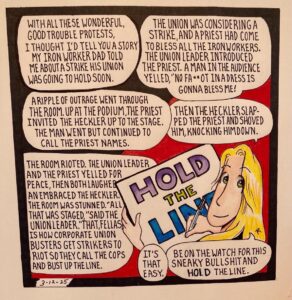The Intermittent Missive – Why not?
October 1, 2025:
With the quantity of the funny, unbelievable, or won’t make the MSM because it doesn’t fit their template, I’m back to daily missives
I believe we are in an irreversible free fall – by Miguel Gonzalez, 30Sep2025
https://miguelgg.substack.com/
One segment of the population has gone from wishing you gone to actually saying “Why not?” and have decided to do what feels good to them which is to do harm to those they do not like and that is bad on itself, but that is not the worst.
Trump Admin Set to Inflict ‘Maximum Pain’ on Democrats if Shutdown Goes Forward: ‘They Will Pay a Huge Price’ – By Jack Davis, 25Sep2025
https://www.westernjournal.
The White House is gearing up for major layoffs if the government shuts down, using the funding gap to cut federal jobs. A memo directs agencies to fire employees from unfunded programs misaligned with Trump’s priorities, per WaPo. Even if funding resumes, only essential staff will stay.
Over 100,000 Federal Workers Are Set To Formally Resign Tomorrow – By Pamela Geller, 29Sep2025
https://gellerreport.com/2025/
Schumer and the Democrats for attempting to force a government shutdown by demanding $1.5 TRILLION for trans surgeries and illegals’ healthcare…“Giving taxpayer money to illegal aliens for healthcare—that’s a crazy idea. Funding transgender surgeries in Peru—that’s a crazy idea.”…More than 100,000 U.S. federal civilian employees will formally resign on September 30, 2025, through the Deferred Resignation Program launched by the Trump administration in January 2025. The program provides paid administrative leave with full benefits until that date in exchange for voluntary departures aimed at reducing bureaucracy, potentially totaling 275,000 exits including retirements and firings.
Governor for Hire – by Tierney’s Real News, 29Sep2025
https://
I believe the swamp wants to run TWO Governors against each other for President that they BOTH control. That way, no matter WHO wins, they STILL control the White House.
The FAFO Consequences of Trump Derangement Syndrome: Lawfare, Cancel Culture, and Murder – by Scott Pinsker, 25Sep2025
https://pjmedia.com/scott-
Sheriff gave dire public warning after being forced to release ‘very dangerous’ inmate. Turns out his warning was warranted. –
by Dave Urbanski, 27Sep2025
https://www.theblaze.com/news/
‘Someone is going to get hurt, and someone is gonna get hurt bad.’
Your ‘Right to Feel Safe’ Doesn’t Trump My Rights, Including Feeling Safe – By Tom Knighton, 26sep2025
https://bearingarms.com/
The idea of concealed and open carry being scary for a lot of people is that the very idea that someone might have a gun is terrifying. I’d like to say I get it, but I really don’t. I can’t understand being so scared of a man-made object, any object, that its mere proximity to it strikes you with fear. People are scared of their proximity, and now with Florida getting open carry, whether the legislature likes it or not, some are…expressing their pathetic, fear-based concerns, such as this college student. (Guns DON”T kill people. People kill people. With bare hands, rocks, hammers, knives, cars, and all kinds of objects. – jlr)(“My anxiety goes through the roof when I walk on FIUs open campuses. It’s no wonder my fear is spiking, given the potential hiding spaces and easy accessibility onto campus grounds.” Tjhis student needs to immediately drop all her classes, withdraw from college and as fast as possible move to a safer state, like NJ or Mass. for her mental health – jlr)
Good morning, Blue Chekists! – What are we offended by this week? – by Ian, 27Sep2025
https://thelawdogfiles.
Well let’s take a look at what’s making everyone take to their fainting couches this week.
good for geese, good for ganders – breaking the frame of “why are they doing this to me?” – by el gato malo, 26Sep2025
https://boriquagato.substack.
let’s take a little stroll down memory lane, shall we?
Tylenol’s concerns about possible autism risk date back more than a decade, documents reportedly show – by Joseph MacKinnon, 27Sep2025
https://www.theblaze.com/news/
A-List Nepo Baby Demands Global Mask Mandates at UN – by Benjamin Bartee, 28sep2025
https://pjmedia.com/benbartee/
Violet Affleck, currently attending Yale University as children of the cultural elite tend to do, appeared for some reason at the United Nations last week to offer her deeply informed opinion that we, as a global community, ought to be enforcing mask mandates in 2025 on account of something called “human rights.”
video – 00:02:18 – https://twitter.com/i/status/
Video Captured Bloody Attack on Pro-Lifer, Yet Alvin Bragg Let Attacker Go Free Anyway – Imagine if the Roles Were Reversed –
By Joe Saunders, 27Sep2025
https://www.westernjournal.
video – 00:08:13 – https://youtu.be/UwrVECzW-KA
let them eat cake moments – immigration as the hill the globalist left will expire upon – by el gato malo, 27Sep2025
https://boriquagato.substack.
the dems in the US have become so desperate and so out of touch that they are having one “let them eat cake” moment after another…imagine threatening to shut down the government unless the american people fund free healthcare, housing, and food for illegals. imagine thinking the public was with you on what’s probably damn near an 80/20 issue. what kind of rabid weasels would need to be running around in your head to not only think this was a good idea but to think you could sell it to the American people as the economy falters for most outside of the upper classes?
Liberals More Likely to Cut Ties with Friends and Family Over Politics – by W. J. Lee, 29Sep2025
https://amac.us/newsline/
(However, since Sept 10th, I don’t think so. I think conservatives are now fed up with, and no longer wish to put up with, the whining, the crying, the feeling-driven rather than fact-based political lectures, the political diatribes and rants, the sulking, the hurt feelings, and the generally divisive drama from their leftist relatives, especially at holiday family gatherings. So they just won’t invite them this year, or maybe ever again, depending on how divisive and abusive they have been to the family – jlr)
Des Moines: Leftists Protest ICE Arrest of Gun-Toting Illegal “School Superintendent” With Fake Degree and Criminal Record –
By Pamela Geller29Sep2025
https://gellerreport.com/2025/
Illegal Alien Arrested by ICE After Targeting DHS Chopper Pilot with Laser Pointer in Portland – By Johnathan Jones, 29Sep2025
https://www.westernjournal.
Pelosi uncorks profanity drenched tirade as ‘Schumer shutdown’ looms – by Sierra Marlee, 30Sep2025
https://www.bizpacreview.com/
video – 00:02:33 – https://youtu.be/Yv79tyrv_qk
Defense Secretary Pete Hegseth addresses senior military officials
video – 00:47:57 – https://www.youtube.com/
Full speech: Trump tells military leaders in Quantico ‘We will be a fighting and winning machine’
video – 01:11:24 – https://www.youtube.com/
Hegseth Tells Generals and Admirals: ‘If the Words I’m Speaking Today Are Making Your Heart Sink … Resign’
https://www.westernjournal.
Secretary Hegseth Summons Global Military Leaders to End Woke Policies and Restore Combat Standards
https://istandforfreedom.com/
The message wasn’t just about rebranding—though the symbolic shift from “Department of Defense” to “Department of War” carries serious weight. Hegseth systematically dismantled years of politically correct military policies, announcing that combat standards would return to the “highest male standard only.” No more lowered requirements. No more diversity quotas compromising readiness.“No more identity months, DEI offices, dudes in dresses,” Hegseth declared bluntly. “We are done with that shit.” The assembled generals and admirals sat in silence as their new marching orders became unmistakably clear: embrace the warrior ethos or find the door
‘Target Practice USA’: Disgusting Charlie Kirk Assassination Sign Posted at ASU – By Katie Jerkovich , 29Sep2025
https://redstate.com/katie-
Government Headed for Shutdown as Democrats Refuse to Negotiate – by AMAC Newsline, 30Sep2025
https://amac.us/newsline/
No, Dems, *We* Don’t Need to Tone Things Down – by Matt Vespa, 29Sep2025
Federal Judge Declares Trump Admin’s Deportation of Pro-Palestinian Protesters Unconstitutional
https://redstate.com/smoosieq/
Massachusetts District Court Judge William G. Young has concluded that the administration’s actions are/were unconstitutional. In doing so, Young makes no secret of his animus toward President Trump (and, by extension, his administration)
rcd via e-mail
Oklahoma Governor Announces 130 Illegal Alien Truck Drivers Arrested in Sting, One CDL Read “No Name Given
https://www.thegatewaypundit.
Check the license out. In the state of New York, the name on license is ‘No name given
Hakeem Jeffries Freaks Out Over Meme Video Posted by Trump: ‘Say It to My Face!’
https://www.westernjournal.
video – 00:00:34 – https://x.com/i/status/










